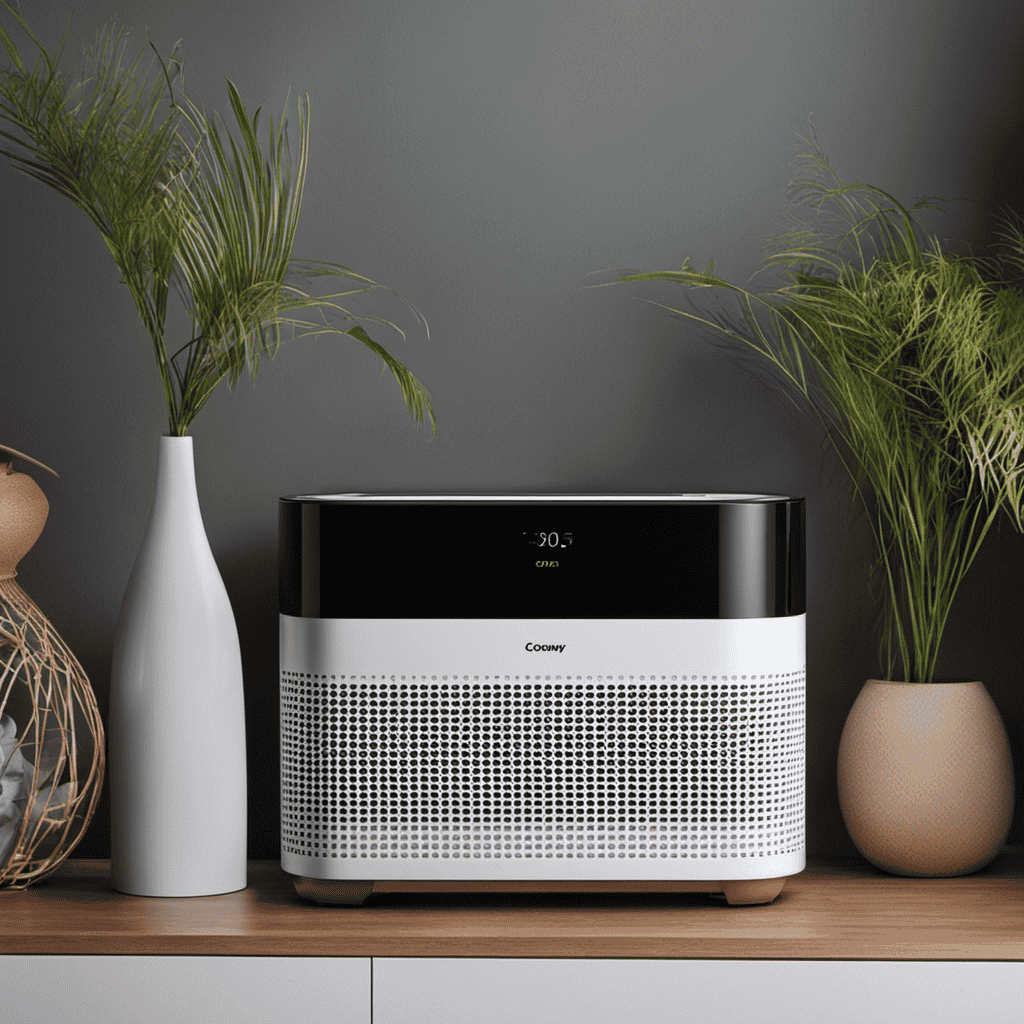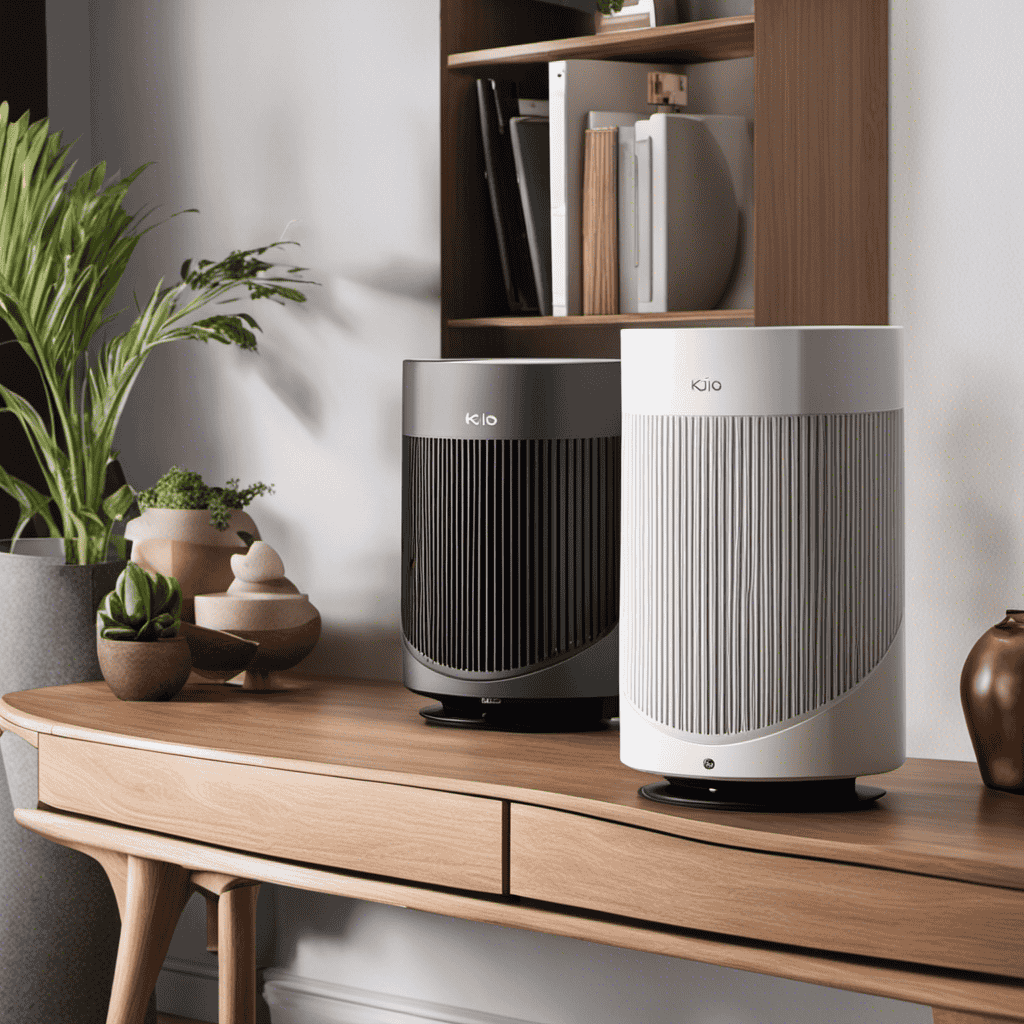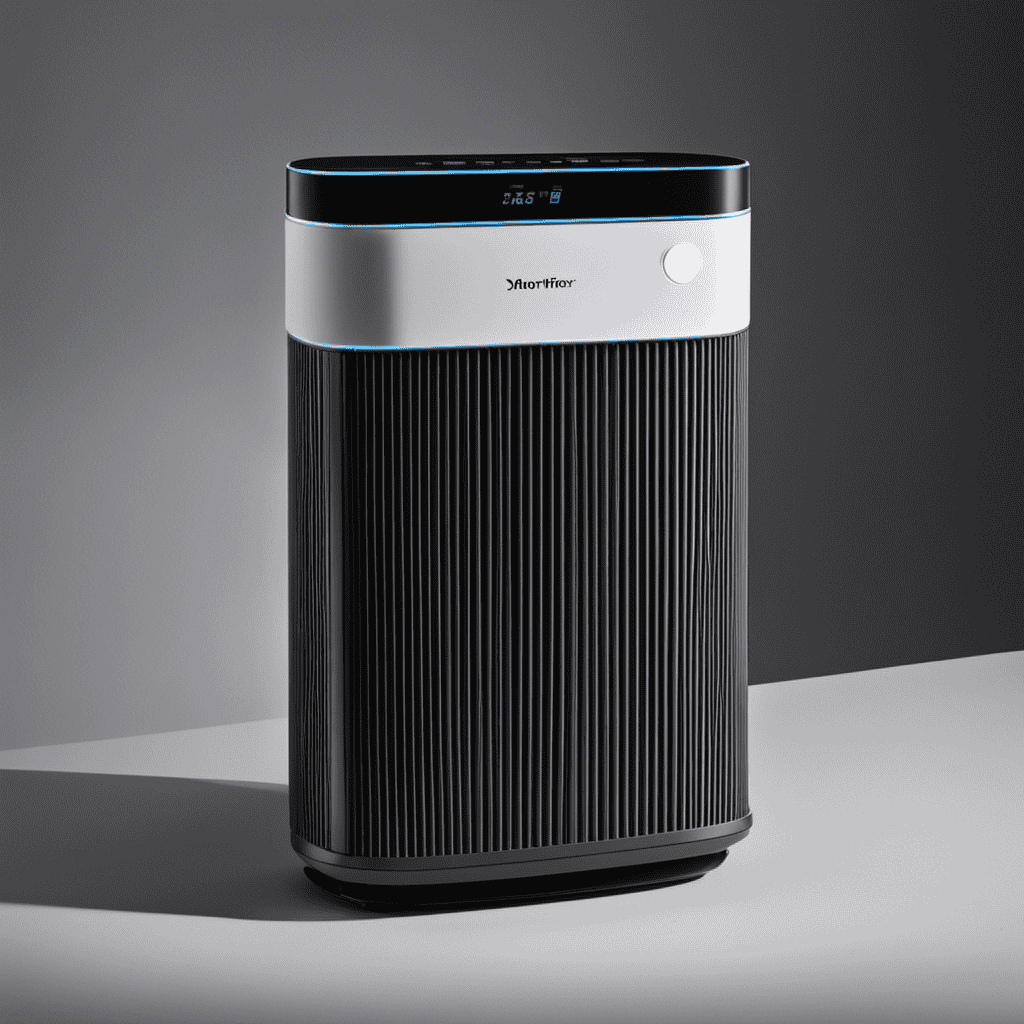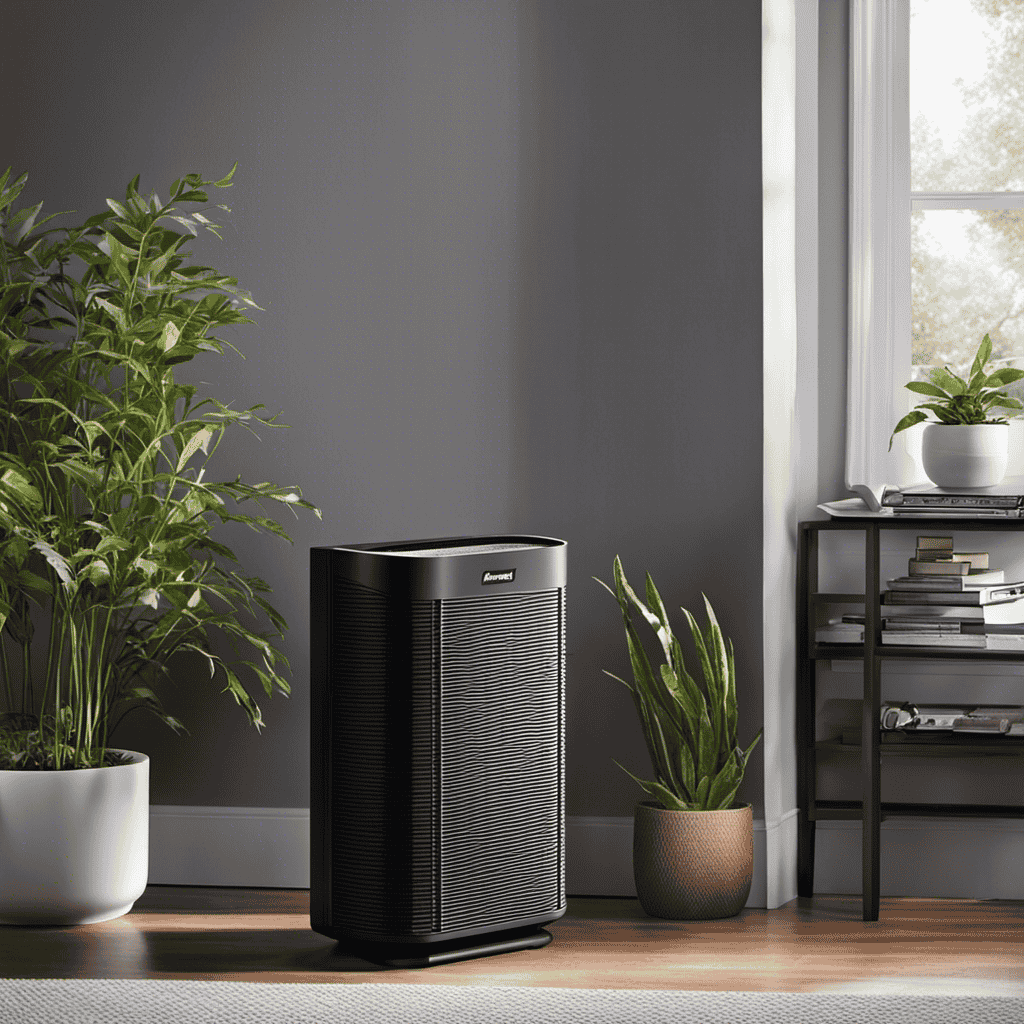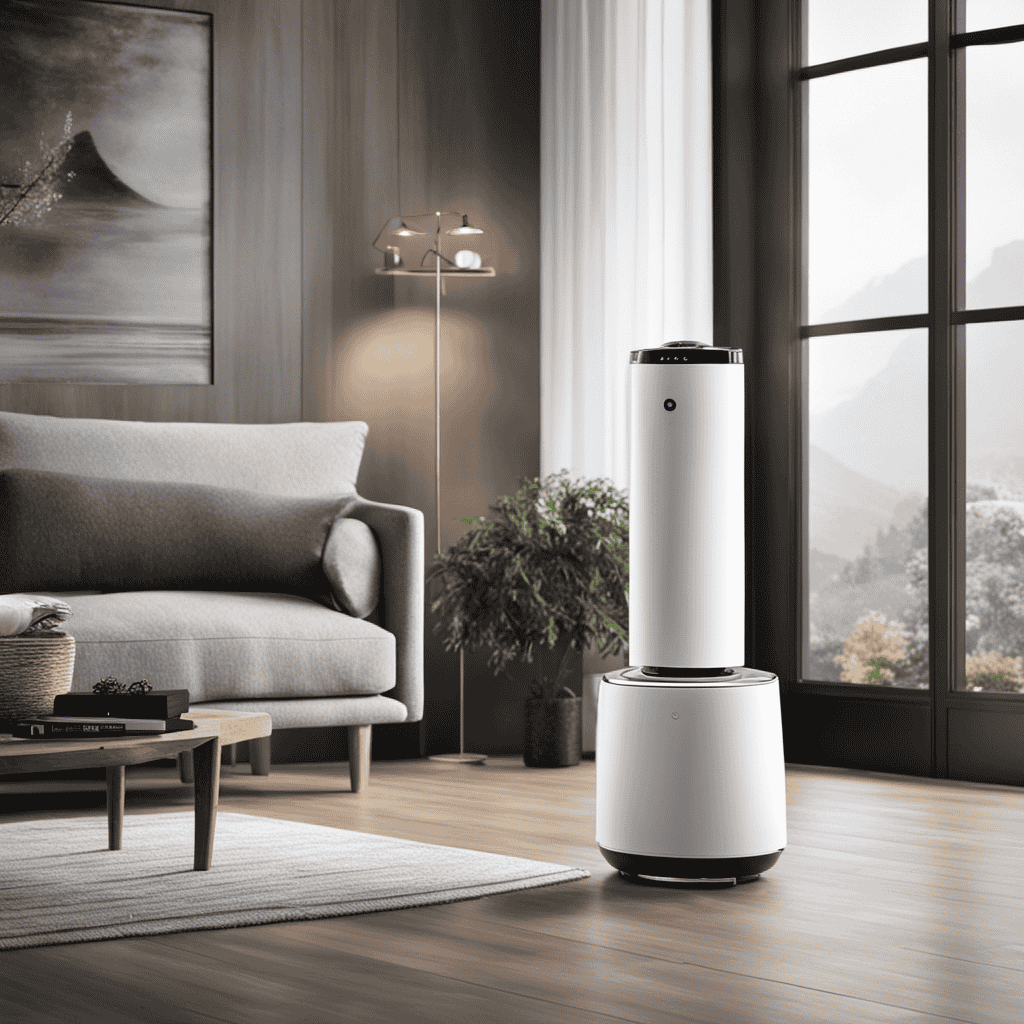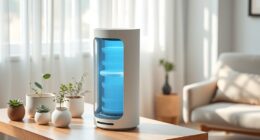I’ve often pondered the mechanism behind air purifiers and their proficiency in removing airborne pollutants. Not long ago, I discovered an intriguing technology known as Plasmawave. This advanced breakthrough has transformed the air purification industry.
In this article, I’ll dive into the science behind Plasmawave, explain how it works in air purifiers, and highlight the numerous benefits it offers. So, if you’re curious about Plasmawave and its role in creating cleaner, healthier indoor environments, you’re in the right place.
Let’s explore the wonders of Plasmawave technology together.
Key Takeaways
- Plasmawave technology effectively removes airborne pollutants and allergens by creating positive and negative ions that combine with water vapor to form hydroxyl radicals.
- It does not produce harmful byproducts like ozone and helps maintain clean and healthy indoor air quality.
- Plasmawave technology works through ionization and hydroxyl radical formation, breaking down pollutants at a molecular level.
- It is safe, efficient, and silent, improving indoor air quality, reducing the risk of respiratory problems, and eliminating unpleasant odors.
The Science Behind Plasmawave Technology
Let me explain the science behind Plasmawave technology in your air purifier.
Plasmawave technology is a revolutionary air purification process that effectively removes airborne pollutants and allergens from your indoor environment. It works by creating positive and negative ions, which combine with water vapor in the air to form hydroxyl radicals.
These hydroxyl radicals then break down harmful contaminants, such as bacteria, viruses, mold spores, and chemical vapors, into harmless substances like water vapor and carbon dioxide. Unlike other air purifiers that use ozone, Plasmawave technology produces no harmful byproducts, making it safe for continuous use.
The benefits of Plasmawave technology are numerous. It not only eliminates odors and allergens but also helps to maintain a clean and healthy indoor air quality. With Plasmawave technology, you can breathe easier and enjoy a fresher, purer living space.
How Does Plasmawave Work in Air Purifiers
Understand how Plasmawave works by creating ions that help neutralize pollutants in the air you breathe. The ionization process begins when the air passes through the Plasmawave chamber. Here’s how it works:
- Plasmawave technology uses high voltage to create both positive and negative ions.
- These ions attach themselves to harmful pollutants, such as allergens, viruses, and odors.
- Once attached, the ions neutralize the pollutants by breaking them down into harmless compounds.
Compared to other technologies, Plasmawave stands out for its effectiveness and safety. Unlike ozone generators that can produce harmful ozone, Plasmawave does not generate any harmful byproducts. It also works in conjunction with other filtration technologies, such as HEPA filters, to provide a comprehensive purification system.
With its unique ionization process, Plasmawave technology offers a powerful solution for improving indoor air quality. In the following section, we will explore the benefits of using Plasmawave in air purifiers.
Benefits of Using Plasmawave in Air Purifiers
When it comes to improving air quality, Plasmawave technology in air purifiers is an excellent choice.
It eliminates harmful particles and helps create a healthier environment by neutralizing pollutants and allergens.
With its precision and efficiency, Plasmawave ensures that the air you breathe is clean and free from any potential health hazards.
Improved Air Quality
Improving air quality is crucial for maintaining a healthy living environment, and the plasmawave in the air purifier helps achieve this goal. The plasmawave technology works by releasing positive and negative ions into the air, which then combine with harmful pollutants to neutralize them.
Here are some key benefits of using plasmawave technology in air purifiers:
-
Air pollution reduction: The plasmawave technology effectively reduces air pollution by neutralizing harmful particles, such as allergens, bacteria, viruses, and volatile organic compounds (VOCs).
-
Health benefits: By eliminating these pollutants, plasmawave helps to improve indoor air quality, reducing the risk of respiratory problems, allergies, and asthma.
-
Odor removal: Plasmawave technology also helps to eliminate unpleasant odors, such as smoke and pet smells, leaving the air fresh and clean.
With its ability to reduce air pollution, provide health benefits, and remove odors, plasmawave technology plays a vital role in improving air quality in our homes and workplaces.
This technology acts as a foundation for the subsequent section about how it eliminates harmful particles.
Eliminates Harmful Particles
Eliminating harmful particles is the main function of the plasmawave technology in air purifiers. This advanced technology is designed to improve indoor air quality and reduce respiratory issues.
By using an electrical discharge, plasmawave technology generates a mix of positive and negative ions. These ions attach themselves to airborne particles such as dust, pollen, and pet dander. The charged particles then cluster together, becoming larger and heavier, making it easier for the air purifier’s filters to capture them.
This process effectively removes harmful particles from the air, preventing them from being inhaled and reducing the risk of respiratory issues.
Plasmawave technology operates silently and does not produce any harmful ozone, making it a safe and efficient solution for improving indoor air quality.
Understanding the Ionization Process in Plasmawave
The ionization process in Plasmawave helps to remove harmful particles from the air. This innovative technology utilizes a combination of positive and negative ions to neutralize pollutants and improve indoor air quality. Here are some key points about the Plasmawave ionization process:
-
Plasmawave technology generates hydroxyls, which are powerful oxidizers that break down and eliminate pollutants such as viruses, bacteria, and allergens.
-
The positively and negatively charged ions produced by Plasmawave attach to airborne particles, causing them to become heavier and fall out of the air.
-
Plasmawave ionization also helps to neutralize odors by breaking down volatile organic compounds (VOCs) into harmless byproducts.
By effectively eliminating harmful particles, reducing odors, and improving air quality, Plasmawave technology offers numerous benefits for both residential and commercial spaces.
Now, let’s delve into the role of Plasmawave in eliminating airborne contaminants.
The Role of Plasmawave in Eliminating Airborne Contaminants
You’ll be amazed at how effectively Plasmawave technology neutralizes airborne contaminants and improves your indoor air quality.
Plasmawave is not only used in air purifiers for homes and offices, but it also has various applications in the medical and automotive industries.
In medical applications, Plasmawave plays a crucial role in eliminating harmful bacteria, viruses, and other pathogens from the air, creating a safer environment for patients and healthcare professionals. Its ability to break down and neutralize these contaminants at a molecular level is unparalleled.
Additionally, Plasmawave is used in automotive air purification systems to remove pollutants and odors, ensuring a clean and fresh cabin environment.
Comparing Plasmawave With Other Air Purification Technologies
When it comes to air purification, two commonly compared technologies are Plasmawave and HEPA filters.
While HEPA filters are effective in capturing airborne particles, Plasmawave technology goes beyond filtration by releasing charged ions that neutralize harmful pollutants.
Additionally, Plasmawave technology differs from UV-C light, which uses ultraviolet radiation to eliminate bacteria and viruses.
Plasmawave Vs. HEPA Filters
If you want to compare Plasmawave and HEPA filters, you should consider their effectiveness in removing different types of pollutants.
Plasmawave technology is known for its effectiveness in neutralizing a wide range of airborne pollutants, including allergens, bacteria, viruses, and odors.
In comparison to HEPA filters, which primarily capture particles through a physical filtration process, Plasmawave technology works by generating positive and negative ions that combine with water molecules in the air to form hydroxyl radicals.
These hydroxyl radicals then break down pollutants at a molecular level, rendering them harmless. This unique approach allows Plasmawave to effectively tackle pollutants that may be too small for HEPA filters to capture.
Additionally, Plasmawave technology does not produce harmful ozone, making it a safe and efficient choice for air purification.
-
Plasmawave effectiveness:
-
Neutralizes a wide range of pollutants
-
Breaks down pollutants at a molecular level
-
Does not produce harmful ozone
-
Plasmawave technology comparison:
-
Works through ionization and hydroxyl radical formation
-
Effective against small particles
-
Safe and efficient choice for air purification
Plasmawave Vs. UV-C Light
To effectively compare Plasmawave and UV-C light, consider the different ways they neutralize pollutants and their ability to target specific types of airborne contaminants. Plasmawave technology works by creating a plasma field that breaks down pollutants at a molecular level, effectively neutralizing them. On the other hand, UV-C light uses ultraviolet radiation to destroy the DNA of microorganisms, rendering them incapable of reproducing. Here is a comparison table highlighting the differences between Plasmawave and UV-C light:
| Plasmawave | UV-C Light |
|---|---|
| Neutralizes pollutants at a molecular level | Destroys microorganisms’ DNA |
| Targets a wide range of airborne contaminants | Primarily effective against bacteria and viruses |
| Safe for humans and pets | Can be harmful if exposed directly |
While Plasmawave technology offers a broader range of pollutant neutralization and is safe for humans and pets, UV-C light is more effective against bacteria and viruses. Now, let’s address some common misconceptions about Plasmawave in air purifiers.
Common Misconceptions About Plasmawave in Air Purifiers
One of the most common misconceptions about Plasmawave in air purifiers is that it produces harmful ozone. In reality, Plasmawave technology is designed to create a balance between air purification and safety.
Here are some key points to address the misconceptions:
-
Plasmawave technology does not generate harmful levels of ozone. It produces only trace amounts that are well below the safety standards set by regulatory bodies.
-
Plasmawave works by creating positive and negative ions that combine with water vapor in the air to form hydroxyl radicals. These radicals then neutralize and break down pollutants, such as bacteria, viruses, and odors.
-
Plasmawave technology is effective in reducing allergens, pet dander, and volatile organic compounds (VOCs). Studies have shown its efficiency in capturing and eliminating these contaminants from the air.
Factors to Consider When Choosing an Air Purifier With Plasmawave
When considering an air purifier with Plasmawave technology, it’s important to take into account factors such as room size, filter type, and noise level.
These features play a crucial role in the overall effectiveness and performance of the air purifier.
Firstly, the room size determines the purifier’s coverage area. It’s essential to choose a purifier that can adequately clean the air in your specific room size to ensure optimal results.
Secondly, the filter type is another crucial factor to consider. Different air purifier brands offer various filter types, such as HEPA filters or activated carbon filters, each targeting specific pollutants.
Lastly, noise level is vital, especially if you plan to use the air purifier in a bedroom or office space. Look for models with adjustable fan speeds to control the noise level according to your preference.
Maintenance and Care for Air Purifiers With Plasmawave
Make sure you regularly clean and replace the filters in your air purifier to maintain its effectiveness and improve the quality of the air in your home. Proper maintenance and care are crucial for ensuring that your air purifier with Plasmawave technology continues to function optimally.
Here are some essential cleaning tips:
- Clean or replace the pre-filter every 3 months to remove large particles such as dust and pet hair.
- Clean the activated carbon filter every 6 months to eliminate odors and harmful gases.
- Replace the HEPA filter annually to capture microscopic particles like pollen and allergens.
By following these maintenance steps, you can ensure that your air purifier with Plasmawave remains efficient in purifying your indoor air.
Now, let’s move on to real-life examples of Plasmawave effectiveness in air purification.
Real-Life Examples of Plasmawave Effectiveness in Air Purification
Regularly cleaning and replacing filters in your air purifier with Plasmawave technology is essential for maintaining its effectiveness and improving indoor air quality.
The benefits of Plasmawave technology extend beyond just homes and offices.
Medical facilities, such as hospitals and clinics, rely on clean and sterile environments to ensure the health and safety of patients. Plasmawave in medical facilities helps to eliminate harmful airborne bacteria, viruses, and allergens, creating a healthier environment for both patients and healthcare professionals.
Similarly, schools and universities can greatly benefit from Plasmawave technology. By reducing the presence of pollutants like dust, mold, and pet dander, Plasmawave in educational institutions improves air quality, creating a more conducive learning environment for students and teachers.
Regular maintenance of air purifiers with Plasmawave technology is crucial in these settings to ensure optimal performance and the highest level of air purification.
Frequently Asked Questions
Are There Any Health Risks Associated With Using Plasmawave in Air Purifiers?
There are potential health risks associated with using Plasmawave in air purifiers. It is important to compare Plasmawave technology with other air purification methods to determine the safest option for your health.
Can Plasmawave Technology Be Harmful to Pets or Plants?
Plasmawave technology in air purifiers may have harmful effects on pets and plants. It is important to consider the environmental impact when using this technology to ensure the well-being of our furry friends and green companions.
How Long Does It Take for Plasmawave to Effectively Purify the Air in a Room?
It takes approximately 30 minutes for Plasmawave technology to effectively purify the air in a room. Plasmawave can be used in conjunction with other air purification methods for enhanced effectiveness.
Are There Any Specific Types of Contaminants That Plasmawave Technology Is Not Effective at Eliminating?
There are some effectiveness limitations to Plasmawave technology when it comes to eliminating specific contaminants. It’s important to note that while it is highly effective against many types of pollutants, there may be some that it is not as effective against.
Can Plasmawave Technology Be Used in Conjunction With Other Air Purification Methods for Enhanced Effectiveness?
Yes, plasmawave technology can be used in hospitals to enhance air purification. It is effective when combined with HEPA filters, providing a comprehensive approach to removing contaminants and improving indoor air quality.
– Is Plasmawave similar to Plasmacluster in terms of air purification?
Yes, Plasmawave and Plasmacluster air purifier technology are similar in terms of air purification. Both use ionized air to neutralize harmful pollutants and allergens, providing clean and healthy indoor air. With their advanced technology, they are effective in removing bacteria, viruses, and odors from the air.
Conclusion
Well, folks, I must say, I’m thoroughly impressed after diving deep into the world of air purifiers and exploring the wonders of Plasmawave technology.
This cutting-edge innovation uses ionization to zap those pesky airborne contaminants into oblivion. Not only does it work like a charm, but it also comes with a plethora of benefits, from neutralizing odors to reducing allergens.
So, if you’re on the hunt for an air purifier, don’t forget to consider the mighty Plasmawave. Trust me, your lungs will thank you.

